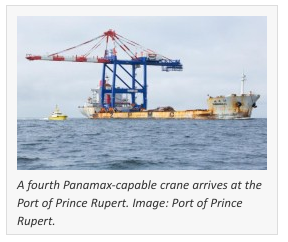Last month the Port of Prince Rupert received another super crane and expanded its capability to receive Panamax ships. The Port now has four super cranes.
 “The arrival of a fourth crane for our container operations will further enhance our ability to quickly and efficiently turn around container vessels at Fairview Terminal. It will add to our already very strong vessel production of 31-plus moves per crane hour” said Mark Schepp, Senior Vice President of Maher Terminals, which operates the terminal. “This further underscores the commitment of Maher Terminals to our steamship line customers and the Port of Prince Rupert.”
“The arrival of a fourth crane for our container operations will further enhance our ability to quickly and efficiently turn around container vessels at Fairview Terminal. It will add to our already very strong vessel production of 31-plus moves per crane hour” said Mark Schepp, Senior Vice President of Maher Terminals, which operates the terminal. “This further underscores the commitment of Maher Terminals to our steamship line customers and the Port of Prince Rupert.”
For years Canadian federal, provincial, port and private funding has been directed to improving and expanding infrastructure at the Ports of Vancouver and Prince Rupert. Elected officials, government agencies and business leaders are determined to increase Canada’s share of Asian imports. Part of the motivation is to increase the number of (high-paying) jobs and sustain the Canadian businesses which depend on trade. Many U.S. transportation and freight stakeholders are envious of what Canada is accomplishing.
Washington State is home to the ports of Seattle, Tacoma, and Everett, the U.S. ports most likely to lose market share to the British Columbia ports. These ports have benefits that extend beyond their metro areas.
Seattle Port Commissioner John Creighton recently explained the importance of the Port of Seattle:
“The maritime industrial cluster in Seattle alone provides, directly and indirectly, over 60,000 family wage jobs and generates over $10 billion in annual revenue for our region (See the 2009 City of Seattle study). Industrial businesses in Seattle, which rely on the efficient movement of freight, account for 35% of the city’s tax base, paying for essential government services for its citizens.”
The Port of Tacoma’s numbers are older and predate some strong growth, but are still impressive:
“The Port of Tacoma is an economic engine for South Puget Sound, with more than 43,000 family-wage jobs in Pierce County and 113,000 jobs across Washington state connected to Port activities. A major gateway to Asia and Alaska, the Port of Tacoma is among the largest container ports in North America. The Port is also a major center for bulk, breakbulk and project/heavy-lift cargoes, as well as automobiles and trucks.”
And the Port of Everett accounts for 34,997 total direct, induced and indirect jobs according to a 2011 study. A total of $3.1 billion of total wages and salaries and local consumption expenditures are created in the local and regional economy by the activity at the Port of Everett.
Last month the Journal of Commerce recognized the Port of Prince Rupert as having the second-highest productivity score in the Americas, based on 2012 container figures.
Just this week, Port Metro Vancouver announced a $106-million expansion to “improve security and help to increase exports to new markets by reducing processing times.”
The Port of Prince Rupert launched an environmental stewardship program in July.
Earlier this summer, Prince Rupert representatives recently visited Ketchikan, Alaska, to discuss business and trade opportunities.
…
Larry Ehl is the founder and publisher of Transportation Issues Daily. In the public sector, Larry was Federal Relations Manager for Washington State DOT; Chief of Staff to US Senator Slade Gorton; and was twice elected to the Edmonds School Board.
Tags: Cascadia, Federal, Freight, Ports, Ports & Freight, Slider






 RSS Feed
RSS Feed